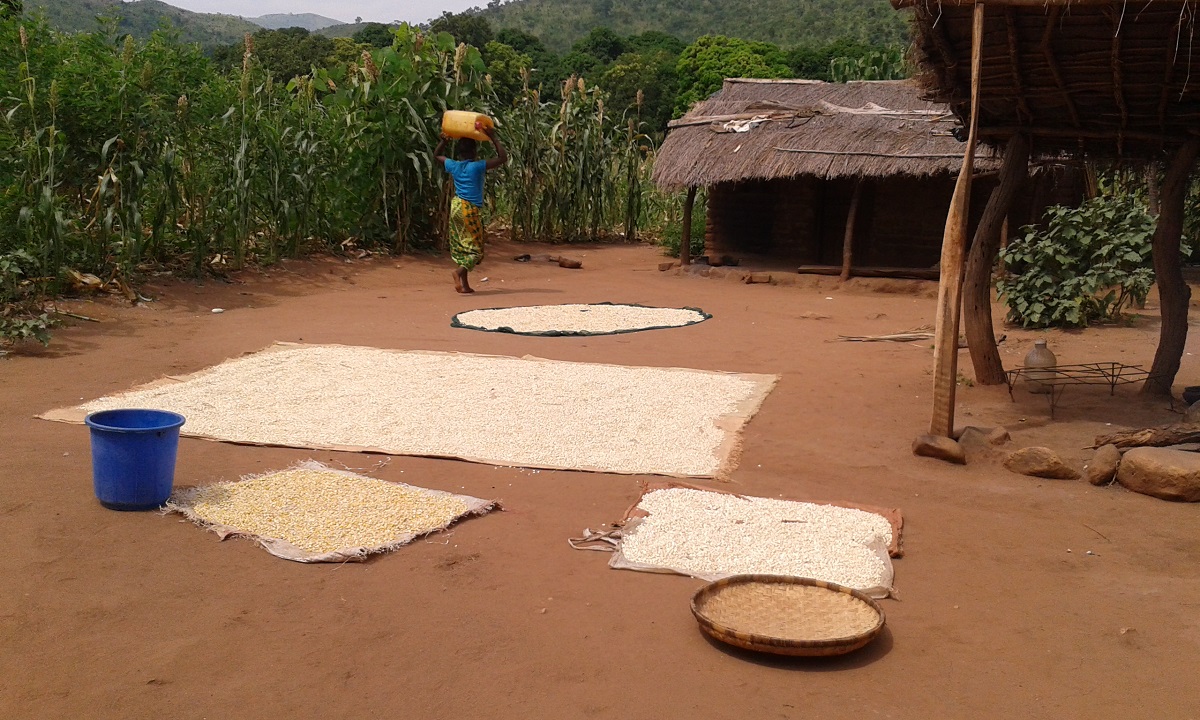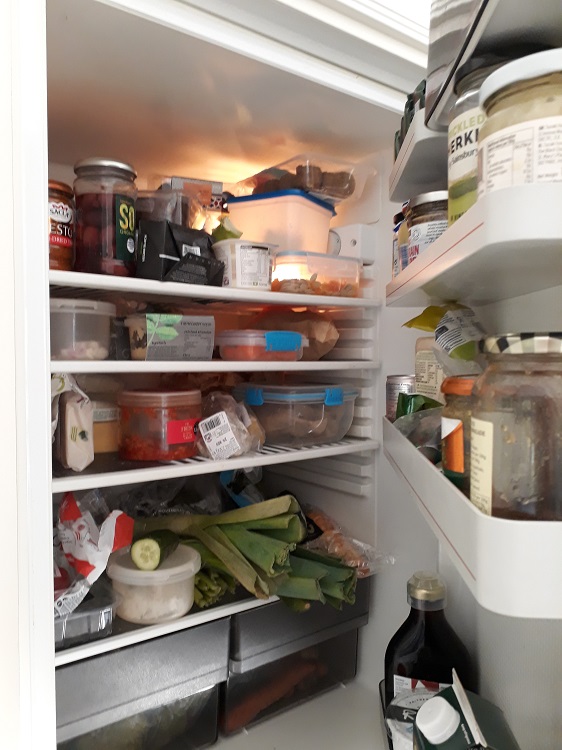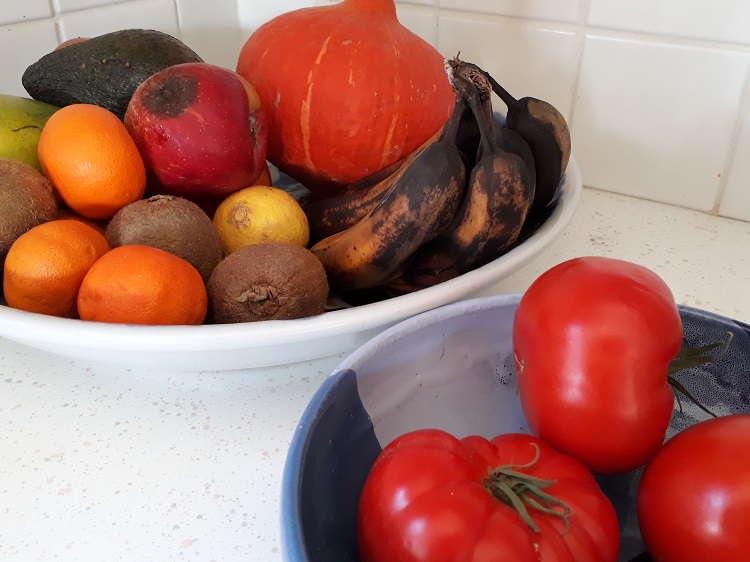
Take a look in your store cupboard, your fridge, your fruit and vegetable rack, your bread bin… How much of that food will be eaten? How much will be wasted? Read on to find out more, including 14 easy actions that we can all do now to reduce our food waste.
Our food, climate and health are inextricably linked. Food systems are currently responsible for a third of global anthropogenic greenhouse gas (GHG) emissions [1, 2]. Choices we make about what we eat, where it comes from, and how it is produced, handled, consumed, or wasted, influence the carbon footprint or ‘foodprint’ and other environmental impacts of our diets and food systems.
Have you ever planted, tended, harvested, and stored a crop, or raised chickens? The resources, effort, and challenges involved in producing and managing sufficient year-round food supply are immense. Yet, a quarter of global food emissions come from food that is never eaten – food that instead gets lost along the supply chain or wasted at the retail or consumption stage.
Food loss and waste reduction has repeatedly been identified as one of the key transformations needed in our food systems to help in delivering food security and mitigating against further climate change [3]. Given the projected food demands of an increased and wealthier population by 2050, and the associated agricultural emissions, analysis suggests the two biggest changes we can make to reduce agricultural GHG emissions are the reduction of food loss and waste and a shift to more sustainable diets [4].
The type of food product and the production, handling and processing system associated with it both influence the emissions profile as well as the proportions that get lost or wasted. So, not only do we need to shift our diets to increase the proportion of foods consumed with typically lower carbon footprints (see here), we also need to make greater efforts to reduce the loss and waste of foods with very high emissions profiles such as, beef, dairy products, not just those that we typically waste in larger volumes (e.g. bread, milk, rice).
As visualised in the food waste hierarchy pyramid, the most effective strategies are those which prevent food loss or waste, followed by those which re-use surplus food, recycle or upcycle food materials into value-added products; where none of these options is possible, the disposal of food waste occurs, which is the least preferable option.
The food waste hierarchy pyramid (Source: Sanchez Lopez et al., 2020 [5] building on earlier versions by Teigiserova et al., 2020; Papargyroploulou et al., 2014; UNEP, 2014).
There are many ways to reduce our food waste foodprint, such as:
- meal planning
- shopping lists
- portion sizes
- meal-kits
- use of the whole plant
- use of leftovers
- freezing foods that will otherwise not be consumed before they deteriorate
- proper storage of perishable foods
- increased awareness of the causes and impacts of food waste and opportunities for reducing it
- monitoring what and how much we waste to target behaviour changes
- shifting to nutritious foods with lower footprints
- avoiding an excess intake of nutrients (overnutrition)
- eating more raw foods
- analysing our cooking and reheating practices
These are just a few of the many tactics we can use; if you would like to share any others that you use to reduce your food waste, you can do so here.
 There are also high-tech fridges entering the market which can scan and identify foods to help consumers plan meals using ingredients in the fridge before their use by date – but such novel technology also attracts a high price tag and may have negative environmental effects in terms of resource use, and disposal of the replaced appliances. Comparable devices which can be retro-fitted to existing fridges are emerging, and further assessment of such technologies will be beneficial in guiding consumers.
There are also high-tech fridges entering the market which can scan and identify foods to help consumers plan meals using ingredients in the fridge before their use by date – but such novel technology also attracts a high price tag and may have negative environmental effects in terms of resource use, and disposal of the replaced appliances. Comparable devices which can be retro-fitted to existing fridges are emerging, and further assessment of such technologies will be beneficial in guiding consumers.
Exciting innovations are also being developed by companies in the smart or active and intelligent packaging field – where food packaging helps to slow spoilage through technologies such as ethylene absorption, modified atmospheres, moisture absorption etc., or packaging fitted with labels which sense and inform us as to the quality of the contents. NRI researchers are working with commercial partners on modified atmosphere storage and packaging trials to reduce the loss and waste of perishable fruits and vegetables on retailers’ and consumers’ shelves and along the UK’s supply chains. Other interesting work is examining opportunities for extracting upcycled plant and seaweed proteins from raw materials otherwise destined to become food loss or waste – helping to develop options for dietary transitions to more sustainable sources of protein as alternatives to livestock products and their associated emissions.
In the last few years, some countries, such as the UK and the Netherlands, have also introduced legislation or agreements requiring businesses to share data on the amount of food waste they generate, and set food and drink waste reduction targets. Campaigns, such as ‘Love Food Hate Waste’, ‘Guardians of Grub’, alongside the world’s first ‘Food Waste Reduction Roadmap’ – in which over 120 businesses will ‘Target, consistently Measure, and Act’ on reducing their food waste – are already making significant progress in achieving the UK’s Courtauld Commitment [6]. By the end of 2023, the European Commission will propose legally binding targets to reduce food waste and revise use-by and best before date marking on food products across the European Union supporting the Farm to Fork Strategy for transitioning to a sustainable food system as part of the European Green Deal. Across the globe, governments have committed to meeting Sustainable Development Goal 12.3 target of halving per capita global food waste at the retail and consumer levels and reducing food losses along production and supply chains, including postharvest losses by 2030. African Union member states have pledged in the 2014 Malabo Declaration to halve postharvest losses by 2025.
Food waste is often framed as a high-income country issue and postharvest food loss as a low- or medium-income country issue, but the evidence and data supporting this narrative is often weak or missing. In the last few years, a small but growing number of studies have measured the quantity of food loss occurring at harvest in high-income countries (e.g., Australia, USA) revealing much larger-than-anticipated levels of food being left in the field at harvest. Similarly, the first few studies measuring African household food waste (from Ghana and South Africa) have revealed quite high levels of waste. This shows the vital importance of building a stronger evidence base on actual food loss and waste occurring along supply chains for different crops and geographies, to facilitate strategic loss reduction investments.
 Following the global food crisis in the 1970s, NRI researchers made a major contribution to developing the methods for objectively assessing food postharvest loss at each stage of the supply chain; improving on the many ‘guesstimated’ total loss figures obtained from surveys or interviews. To reduce losses, it is necessary to understand where, why and at what scale they are occurring within food systems. A number of NRI researchers continue to work collaboratively with research partners in sub-Saharan African countries on reducing postharvest losses within their food systems. For example, this includes working with farmers and those who provide services to them to test and compare different crop storage methods and technologies, transforming crops into less perishable and higher value products, developing training on safe food storage practices for warehouse managers, developing and testing solar-powered cool stores, or using existing research to build postharvest loss information systems [7] or databases on effective loss reduction interventions [8, 9]. An early NRI led think-piece [10] also drew attention to how climatic changes affect not just the crop production stages and yield outcomes, but also the postharvest activities and outcomes in numerous different ways. Studies exploring smallholder farmers’ and other stakeholders’ perceptions of climatic changes and how they are influencing their postharvest systems followed. Multi-stakeholder learning platforms have also been supported to evaluate different postharvest management options in varied climatic conditions to help communities in some of the world’s most climate change vulnerable regions to cope, adapt and lessen future impacts on the postharvest aspects of their food systems.
Following the global food crisis in the 1970s, NRI researchers made a major contribution to developing the methods for objectively assessing food postharvest loss at each stage of the supply chain; improving on the many ‘guesstimated’ total loss figures obtained from surveys or interviews. To reduce losses, it is necessary to understand where, why and at what scale they are occurring within food systems. A number of NRI researchers continue to work collaboratively with research partners in sub-Saharan African countries on reducing postharvest losses within their food systems. For example, this includes working with farmers and those who provide services to them to test and compare different crop storage methods and technologies, transforming crops into less perishable and higher value products, developing training on safe food storage practices for warehouse managers, developing and testing solar-powered cool stores, or using existing research to build postharvest loss information systems [7] or databases on effective loss reduction interventions [8, 9]. An early NRI led think-piece [10] also drew attention to how climatic changes affect not just the crop production stages and yield outcomes, but also the postharvest activities and outcomes in numerous different ways. Studies exploring smallholder farmers’ and other stakeholders’ perceptions of climatic changes and how they are influencing their postharvest systems followed. Multi-stakeholder learning platforms have also been supported to evaluate different postharvest management options in varied climatic conditions to help communities in some of the world’s most climate change vulnerable regions to cope, adapt and lessen future impacts on the postharvest aspects of their food systems.
As the world watches the outcomes of the COP26 Glasgow Climate Pact and hopes that promised financing will materialise, action is needed from every part of society to transform the way we manage ecosystems and produce, handle and consume food. It is easy to feel we are powerless, but by shifting to more sustainable diets and reducing the amount of food we waste, each of us can help to reduce the GHG emissions of our food system. Individual actions are valuable, but it is also essential that we call on governments to facilitate such shifts in consumer and business behaviour through regulatory, policy and technological changes to support the transition towards net zero.
References
[1] Crippa, M., Solazzo, E., Guizzardi, D. et al. 2021. Food systems are responsible for a third of global anthropogenic GHG emissions. Nature Food, 2, 198–209. https://doi.org/10.1038/s43016-021-00225-9
[2] Tubiello, F.N., Rozenzweig, C., Conchedda, G. et al. 2021. Greenhouse gas emissions from food systems: building the evidence base. Environmental Research Letters, 16, 065007
[3] Willett, W., Rockstrom, J., Loken., B. et al. 2019. Food in the Anthropocene: the EAT-Lancet Commission on healthy diets from sustainable food systems. The Lancet Commission, 393, 10170: 447-492. https://doi.org/10.1016/S0140-6736(18)31788-4
[4] World Resources Institute. 2018. Creating a sustainable food future. 96pp.
[5] Sanchez Lopez, J., Patinha Caldeira, C., De Laurentiis, V., Sala, S., Avramides, M., 2020. Brief on food waste in the European Union, Avraamides, M., (Eds), European Commission, 2020, JRC121196.
[6] WRAP. 2020. Courtauld Commitment 2025 Milestone Progress Report. 38 pp. https://wrap.org.uk/resources/report/courtauld-commitment-2025-milestone-progress-report
[7] The African Postharvest Loss Information System (APHLIS www.aphlis.net )
[8] Stathers, T., Holcroft, D., Kitinoja, L. et al. 2020. A scoping review of interventions for crop postharvest loss reduction in sub-Saharan Africa and South Asia. Nat Sustain 3, 821–835. https://rdcu.be/cBRHB
[9] Postharvest loss reduction interventions database https://phceres2030.net/
[10] Stathers, T., Lamboll, R. & Mvumi, B.M. 2013. Postharvest agriculture in changing climates: its importance to African smallholder farmers. Food Sec. 5, 361–392. https://doi.org/10.1007/s12571-013-0262-z


![The food waste hierarchy pyramid (Source: Sanchez Lopez et al., 2020 [5]) Food waste hierarchy pyramid Sanchez Lopez et al 2020](/images/images/nri-news/2021/Food-waste-hierarchy-pyramid_Sanchez-Lopez-et-al-2020.png)